Everyone enjoys taking on large jobs on their own, especially when it means saving money by taking on a job that would otherwise be left to the experts. One of the duties appears to be moving a piano. Piano moving can be a dreaded task that many owners often fear to attempt. Moving the large instrument from room to room or sometimes to different floors isn’t always an easy task. Many people believe that all it takes to move a piano is a muscle, but safeguarding it is just as essential.
Although everyone knows that a piano has 88 keys, did you realize that they often contain over 10,000 moving parts? It may be difficult to move such a fragile, heavy, and intricate instrument without harming it, and specialists are best prepared to do so securely. You can accomplish it on your own, but it will require some planning and a lot of support. This article will explore how to move a piano the right way and all the details you need to prep.
Following these guidelines will guarantee the easiest way to move a piano and that the Piano Moving Company can do its duties efficiently.
Piano Moving Options
When moving a piano, there are two routes to take. To hire professional piano movers or to merely move a piano yourself. So what’s the better option? Well, it comes down to whether or not you want to put in the extra work to do it yourself or would rather directly pay someone to do it for you.
Identify The Type Of Piano
In some cases, it is necessary to disassemble a piano before moving it. Therefore, knowing the piano model is vital to disassembling and reassembling correctly.
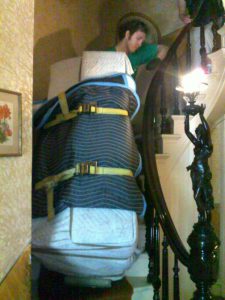
Don’t Take Apart The Piano
If you have a grand piano, the movers will be able to disassemble the lid, lyre, and legs so that they may be transported more easily. If you have an upright piano, the casters will most likely be removed to assist balance it on the transporting dolly. Cleaning the casters to eliminate dirt and dust might help the movers remove them more easily.
Blankets Should Be Wrapped Around The Piano
These instruments have a delicate finish that can be easily scratched or damaged. To protect against this, cover the keyboard with protective, non-slip blankets. To avoid scratches and gouges on the piano’s surface, use a piano pad. Otherwise, it may be necessary to refinish it later, which may be pricey. You won’t have to cover the piano in blankets because most piano movers will do it for you.
Inquire About The Gear
Verify that the moving firm has the necessary piano-moving equipment, such as a dolly and a piano board. The dolly must be capable of supporting the piano’s weight while it is attached to the board. Ramps, slings, shifting pads, and piano skids are some of the other items that most moving firms have on available.

Make A Strategy Before Transporting A Piano
Discuss the best manner to transfer the piano out of your house and into the new place when you make the appointment. Then, ahead of time, eliminate difficulties by establishing a path for the movers to follow at both locations.
Below Are Some Piano Moving Tips If You Want To Know How To Move A Piano Yourself:
- Enlist as many helpers as possible
- You’ll need a lot of support because the weights are quite heavy. Even the tiniest upright piano will require at least three persons to properly transport it from one location to another. Keep in mind that dropping a piano has serious repercussions.
- Measure doorways, staircases and hallways
- Start by clearing the pathways. Make sure you have a clear route from the door of the place you’re leaving to the door of your new house, as well as from the door of your new house to the piano’s position. Take a look at the route you’re on. If you have to take the piano up or downstairs, check sure the steps can support the size and weight of the instrument before you begin.
- Measure the new space
- You’ll want to double-check that your piano will fit in its new home. Make sure there are no impediments in the way of transporting the instrument to its new home by measuring the room, doorways, and stairwells.
- Make sure you have the right equipment for the job
- You’ll need piano dollies, harnesses, and padding at the absolute least. However, depending on the sort of piano you have, the precise items you’ll need may differ.
Verify What Size Moving Truck You’ll Need
Make a list of everything you own, especially major things like your piano and other furniture, and use it to figure out what size moving truck you’ll need for your move. Trucks often range in length from 10 to 26 feet. The size of the vehicle you choose has a significant influence on the amount of time, money, and overall success of your relocation. You’ll squander money on space you don’t need if you rent one that’s too big. Plus, when your belongings move and tumble around in the rear, you run the danger of them being destroyed. Renting a truck that is too tiny, on the other hand, entails unexpected treks back and forth, which means more petrol money, a longer day, and glares and grumbles from the buddies you’ve enlisted to assist you. Furthermore, most businesses charge by the mile, so making numerous journeys would significantly raise prices. In the worst-case situation, you may need to hire a second moving van.
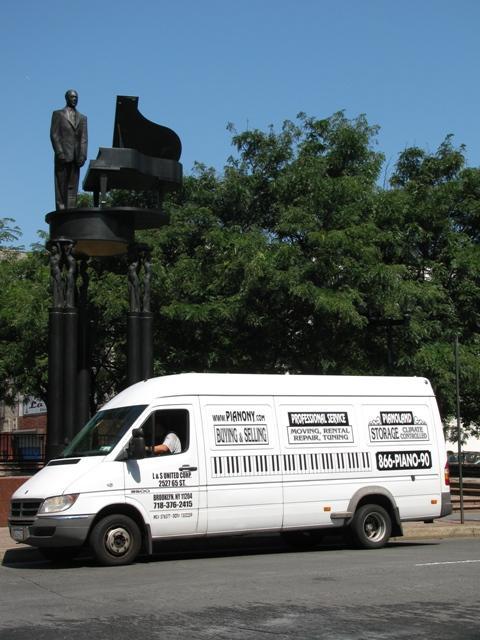
Piano Dollies Are Required For An Upright Piano
To transport a grand piano, you’ll need a specific piece of equipment known as a piano board or piano skid board. Additional strapping and padding are required for this board, and it must be the correct size for your piano.
What Not To Do When Moving A Piano
Don’t forget pianos are heavy. Putting the piano on a scale to determine the size of the work isn’t an option. So, how do you figure out how much the piano weighs, because that weight informs your moving strategy as you traverse narrow passages, curves, doorways, and, maybe worst of all, stairs?
The weight of a piano varies considerably depending on the model. The weight of a grand piano can range from 1,400 pounds to 500 pounds. A model that is less than 48 inches tall and weighs less than 300 pounds is an upright model. A piano that is 48 inches tall or greater can weigh up to 800 pounds.
The weights of several well-known piano brands and types of different piano weights are listed below:
Upright Approx. weight:
- Young Chang 121: 500 lbs
- Steinway & Sons Model 1098: 485 lbs
- Bösendorfer 130: 580 lbs
- Baldwin BH-122: 5420 lbs
- Yamaha P22: 495 lbs
- Steinway & Sons Model K-52: 620 lbs
- Kawai K300: 520 lbs
- Mason & Hamlin Artist Grand Piano BB: 1,100 lbs
- Steinway Model D Concert Grand Piano: 1000 lbs
- Steinway Model S: 550 lbs
- Yamaha C3 Studio: 700 lbs
- Young Chang Y185: 670 lbs
- Mason & Hamlin CC: 1,400 lbs
- Steinway & Sons Model B: 765 lbs

Don’t Skimp On Help
Don’t be stingy with your assistance. You’ll need a lot of support because the weights are quite heavy. Even the tiniest upright piano will require at least three persons to properly transport it from one location to another. Keep in mind that dropping a piano has serious repercussions.
Don’t Try To Lift The Piano Without Equipment
Do not attempt to raise the piano without the proper equipment. Make sure you have the proper gear and protection. Not all dollies are made equal. A four-wheel piano dolly, custom-made piano padding, and specific piano straps adjusted to the proper tension are all required.
Don’t Rely On The Casters On Your Piano (If It Has Them)
They’re not designed to roll long distances, and they deteriorate with time. Those rollers might also become stuck. This might result in ripped carpet and severe scrapes on the floor.

Don’t Move Too Quickly
Moving a piano is difficult, and piano transporting should not be attempted in haste. Moving too quickly can lead to errors, which can result in injuries to you, your coworkers, your flooring, and your walls, among other things.
The Bottom Line On Pianos That Move
Whether you hire a professional piano mover or handle it yourself, be sure you understand all of the expenses and hazards involved. If you hire a professional mover, the cost of the move might range from $200 to $1,200, depending on the size of the piano, the distance you’re transporting it, and whether or not you’re carrying it up or downstairs. With movers, there are fewer chances of damage and injury since they utilize the proper equipment and procedures and will know the best approach to transfer your piano into its new location. It will undoubtedly save you money if you do it yourself, but there is a significant risk that something will be broken or someone will be injured if you do not have all of the necessary tools. It might be wise to spare everyone the trouble and enlist the assistance of someone who understands what they’re doing. In the long run, it will save you time and potentially money (if the piano breaks down).
How To Move An Upright Piano (Step By Step)
1. Use a blanket and tape to protect the keys and pedals when the upright piano moving.
2. Make sure there is someone on both sides of the piano to keep an eye on it.
3. Place the piano on a dolly.
4. Secure the piano and load it onto the vehicle.

How To Move A Grand Piano (Step By Step)
Because moving a grand piano differs slightly from upright piano moving:
1. Fasten the top lid by lowering it.
2. Remove the piano’s legs and pedals.
3. Pack the pedals and legs of the piano in a separate box and protect them with packing blankets.
4. Enlist the help of others to support the piano lid while the legs are being disassembled.
5. Use moving blankets to wrap the piano’s lid, keys, and sides and secure them with tape.
6. Attach the piano with straps by gently tilting it onto the board.
8. Load the piano onto the pickup vehicle
9. Put the piano back together in its new location.
FAQs
How Much Does It Cost To Move A Piano?
The typical piano relocation cost is between $200 and $400 for local removals. The typical piano relocation cost for long-distance transfers is between $700 and $2,000.
When deciding whether to hire professional movers to transport your piano or handle it yourself, it’s critical to weigh all of the costs involved. Packing, labour, vehicle rental, gasoline, time, and set-up all have expenses. Each circumstance will be unique. Most moves can be pricey, so be sure to get a quote before committing to anything.
There’s also the matter of tipping movers to consider. This must also be factored into your cost estimate. Tips might range from $20 to $100 depending on the number of movers and the length of the relocation.
How Much Does A Piano Weigh?
There are two types of pianos: upright and grand. Upright pianos have strings that run vertically within the casing and stand tall vertically. The strings of grand and baby grand pianos run in a more horizontal direction. The weights will differ depending on the style and company.
To transport most pianos, you’ll need at least two persons and the appropriate equipment. If you’re going into an area with a lot of barriers or a tough road to travel, you could require more personnel.

What Do You Need To Move A Piano?
- Piano dollies are unique dollies with four wheels, additional bearings for smoother turning, and rubber wheels to protect flooring.
To keep the piano on the dolly or the piano board, you’ll need sturdy strapping. Look for locking straps or straps with ratchets to make tightening and securing the strapping a breeze. A “hump strap” is another option to explore. By extending the usage of your arms, it aids in the lifting of large, heavy objects. This is very helpful while climbing stairs. Wrap it around your wrists, then through the bottom of the piano’s wheels, and slowly raise up. - A piano board, also known as a skid board, is a big piece of plywood that has been padded. A skid board is used to move a piano by strapping the instrument’s body to it. The body is then relocated by placing the board on a piano dolly.
- Pads or blankets for movers: These blankets or pads will protect your piano’s finish throughout the relocation. They help shield the piano from straps, tape, and other bumps that may occur during transit.
- Shoulder harness or belt: This strap system helps movers to lift heavy things by appropriately using their legs and shoulders. It won’t improve your carrying capacity, but it will help you avoid accidents caused by incorrect lifting. Use this for piano lifting.
Can You Move A Piano On Its Sides?
A piano is not usually harmed by being moved on its back or side when done by a professional moving team. A piano may be moved, tilted, and turned without causing harm. When a piano is dropped or banged, or when foreign items are within the piano while it is moving, it might be damaged and will need to be repaired.
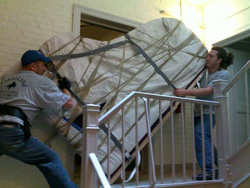
Is It Possible To Move An Upright Piano On Its Back?
No, the piano’s internal mechanics should not be moved from their default position. If you can’t get the piano to move in this natural position, do not move it at all. Moreover, it is very hard to lay a piano flat without harming it.
Does Moving A Piano Affect Tuning?
Even if you move your piano across the room, it must be tuned once it has been moved. When you relocate a piano, give it three weeks to settle before calling a piano tuner. It will take some time for the piano to adjust to its new surroundings. Even if you tune it right away, it will not stay tuned. That’s why it’s recommended that you wait a few weeks before tuning the piano.
What’s The Best Type Of Vehicle To Use When Moving A Piano?
If you’re moving an upright piano, a ‘dual-dolly’ system for the piano dolly comes in handy. The advantage of using a specialized piano dolly would be that the object’s weight is shifted to the dolly’s wheels rather than the wheels of the piano. This should be used to transport the piano from the location to a big cargo van that has a ramp (or rent one). Now that the piano is easily moveable on the dolly, you must transport it to the cargo van’s rear. Please don’t try to carry a piano up or down a flight of steps. It’s far preferable to entrust this task to a professional piano moving company. Before you start to move, make sure you clear away to the vehicle. Two individuals should be able to roll the piano and steer it in the right direction. It is advised that the piano be loaded into the cargo van with the right-hand keys first. Move the piano to the sidewall as near the cabin wall as feasible while inside the vehicle.

Some Examples Include:
The Ford Transit 250 Mid Roof
The Ford Transit 250 Mid Roof and 250 High Roof models pass our test with flying colours.
Because of the large internal cargo room, can and kept flat and You may tie safety straps to a variety of places to keep the piano in place.
RAM Promaster Mid/High Roof
The roof can be either a Mid or a High roof. The RAM Promaster Models can easily accommodate pianos. If at all feasible, choose the wheelbase that is somewhat longer to ensure that you have some wiggling space. This car’s wheel arch is perfectly situated further back towards the back of the truck, allowing the piano to rest snugly against the sidewall.
Mercedes Sprinter
We found that the Mercedes Sprinter series had the most height, with even the low roof type being taller than the similar Ford vehicle. Expect to pay a little extra for the Mercedes’ luxury name.
Are There Any Off-Limit Areas That Should Stay Out Of Reach From My Piano When I’m Transporting It?
It is best to avoid lifting the keys of the piano as they are more delicate. That is an off-limit area when transporting the piano.
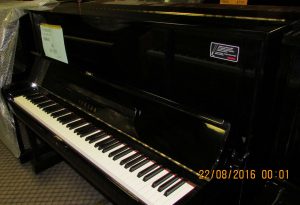
Do You Have Any Tips On How To Protect The Keys During The Move?
Secure it in place if it has locks to protect the keys from harm while traveling. If somehow the lid doesn’t have a lock, fasten it with tape that will not harm the pianos paint or stain. Place the large moving blankets across the top, keys, and all edges of the piano and fasten them with packing tape. Wrap moving blankets and tape around each foot and pedal individually.
Do You Have Any Safety Tips For Moving Pianos?
- Raise with your knees bent
- Take your time
- Double ensure that the whole surface of the piano is securely fastened
- Use all equipment, especially dollies
- Enlist the assistance of numerous individuals
- Seek professional assistance
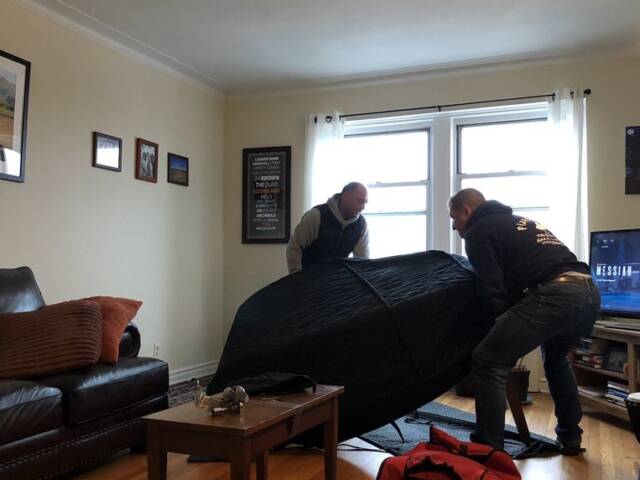
Take your time to choose an outfit that is both comfy and versatile.
Trousers that are too tight, for example, may rip when you stoop to move the piano. Wear sports shoes or work boots with a treaded sole that provides good traction on indoor and outdoor surfaces. To assist you to obtain a stronger grip on the piano, wear a pair of work gloves with rubberized palms. Wearing lengthy necklaces or bracelets that might get stuck in tiny areas while moving is not a good idea. Excessive baggy clothes should also be avoided since they might become stuck in the movement of things.
What Are Some Of The Most Common Mistakes People Make When It Comes To Moving Pianos?
- Using incorrect equipment
- Using an untrustworthy relocation company
- On a moving day, wearing incorrect clothing or footwear
- Trying to move the piano in a messy room
For Further Assistance
If moving a piano yourself isn’t your thing, we are a professional moving business that can help. Moving a piano might be intimidating, but our years of expertise have made it simple for us. We are well-versed in all the tricks, tips, and techniques. We are the most qualified movers for transferring your possessions, including your piano. With a large network of reputable and trustworthy employees, we would be happy to help. To give you even more peace of mind, we are certified and insured, so you can trust that your transition (and your piano’s move) will be in excellent hands. Contact us today at Piano NY! Wishing you success and a smooth move!
